Reduced mortality in Atlantic salmon fed diets supplemented with nucleotides
In 2006, the Chilean salmon industry produced 600,000 MT of salmonids, of which 10% were produced by Empresas AquaChile S.A., the second largest salmonid producer in the world (Aqua.cl, 2006).
In that same year Chilean salmon producers sustained an approximate 12% loss due to mortality (SGS Aquatic Health, 2006). Over half of this loss can be attributed to health-related stressors such as viral, bacterial and/or pathogenic outbreaks (e.g., salmonid rickettsial septicaemia (SRS), infectious pancreatic necrosis, Vibrio). To combat sickness and reduce related mortality, medicated diets are commonly prescribed and fed after signs of outbreak appear.
In 2006, Chilean salmon producers used 900,000 MT of feed, of which 12% was medicated at a total cost of $25 million USD. In view of concerns over antibiotic resistance, usage bans in Europe, usage restrictions in the United States, and increasing costs associated with medication, alternatives to medicated feeds are now of prime interest to the industry (Patterson and Burkholder, 2003).
After the reports of Burrells et al. (2001a,b) that dietary supplementation with nucleotides enhanced immune response and vaccine efficacy in salmonids, interest in nucleotide supplementation has increased worldwide (Li and Gatlin, 2006).
The Chilean salmon farming industry is one place where nucleotides could have a large positive impact if the reported increased immune response translates to reductions in mortality, antibiotic use, and production costs. Trials were conducted by AquaChile to examine the response of Atlantic salmon fed diets supplemented with nucleotides to challenge with SRS, the bacterial pathogen responsible for most of the mortality suffered in Chilean salmon farming.
Materials and methods
TRIAL 1. P. SALMONIS LD50 DETERMINATION
Four groups of 60 Atlantic salmon (Salmo salar), initial body weight (IBW) 60 g, were randomly distributed to 350-L tanks maintained with well aerated (8-10 mg/L dissolved oxygen) salt water at 15 °C. All fish were fed the commercial control diet later used in Trial 2. After being acclimated for 14 days, fish were challenged with four different doses of Piscirickettsia salmonis to determine the median lethal dose (LD50) (Figure 1).
The calculated LD50 was used as the dose administered to fish in Trial 2.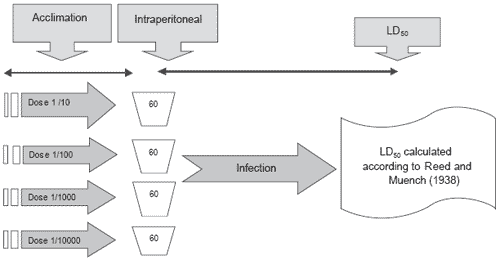
Figure 1. Experimental design.
TRIAL 2. NUCLEOTIDE FEEDING / P. SALMONIS CHALLENGE
Eight hundred Atlantic salmon (Salmo salar) smolt, IBW 44 g, were tagged using passive integrated transponder (PIT) tags and randomly distributed to ten 700-L tanks.
Fish were maintained in well aerated (8-10 mg/L) salt water (30-35 ppt salinity) at ambient temperature (12-17 °C). Fish were acclimated for 14 days and fed the control commercial diet. During the 60-day trial, fish were fed a commercial feed (3% BW/ day) with or without supplemental nucleotide sources (Table 1).
On day 30, fish were challenged with P. salmonis at the LD50 dosage determined in trial 1 to examine the effect of supplemental nucleotides on fish mortality until day 60. Temperature, mortality and feed intake were measured daily. Whole body weight and length were measured on days 0, 30 and 60.
Table 1. Experimental diets for Trial 2.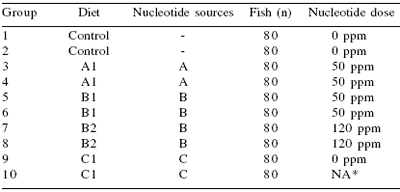
*Not available
Results
TRIAL 1. LD50 DETERMINATION
The cumulative mortality of the groups of fish challenged with different doses of P. salmonis are displayed in Figure 2. As expected, higher doses of P. salmonis resulted in higher mortality. The LD50 was calculated to be a dilution factor of 1/95.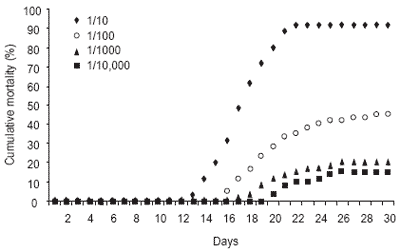
Figure 2. Cumulative mortality for treatment groups in Trial 1.
TRIAL 2. NUCLEOTIDE FEEDING / P. SALMONIS CHALLENGE
Weight gains and growth rates of the fish challenged with P. salmonis indicate that dietary nucleotides did not greatly improve the growth of salmon over that of fish fed the control diet (Table 2). Although the specific growth rate (SGR) of the fish fed nucleotide source B was greater that that of the control and diets that included sources A and C, the difference was not significant.
Table 2. Growth data of the fish from Trial 2.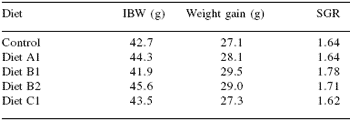
Cumulative mortality data from Trial 2 show that dietary nucleotide supplementation was effective in reducing the mortality of fish challenged with P. salmonis compared with those fed the control diet (Figure 3). Fish fed the control diet suffered a mortality rate of 51% compared with an average rate of less than 39% for fish fed nucleotides.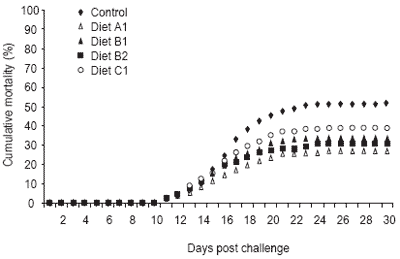
Figure 3. Cumulative mortality for treatment groups in Trial 2.
| Conclusion Dietary nucleotides can improve the immune response of Atlantic salmon smolt challenged with P. salmonis. Fish supplemented with nucleotides had at least 12% lower mortality than fish fed the control diet. |
References
Aqua.cl 2006. Estadísticas de acuicultura y pesca: enero 2006. http://aqua.cl/estadisticas/ ESTADISTICAS109.pdf.
Burrells, C., P.D. Williams and P.F. Forno. 2001a. Dietary nucleotides: a novel supplement in fish feeds. 1: Effects on resistance to disease in salmonids. Aquaculture 199:159- 169.
Burrells, C., P.D. Williams, P.J. Southgate and S.L. Wadsworth. 2001b. Dietary nucleotides: a novel supplement in fish feeds. 2: Effects on vaccination, salt water transfer, growth rates and physiology of Atlantic salmon (Salmo salar L.). Aquaculture 199:171-184.
Li, P. and D.M. Gatlin III. 2006. Nucleotide nutrition in fish: current knowledge and future applications. Aquaculture 251:141-152
Patterson, J.A. and K.M. Burkholder. 2003. Application of prebiotics and probiotics in poultry production. Poult. Sci. 82:627-631.
Reed, L.J. and J. Muench. 1938. A simple method of estimating fifty percent endpoints. Am. J. Hyg. 27:493-497.
SGS Aquatic Health. 2006. Informe N° 33 / etapa de engorda / noviembre 2006: mortalidades mensuales y acumuladas por especie.




.jpg&w=3840&q=75)